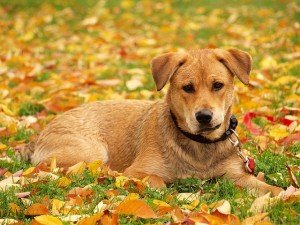10 Pet Safety Tips for Autumn
By Jordan Walker
Jordan loves pets and animals. He contributes regularly to Coops And Cages and other blogs where he shares his passion and vast knowledge about our furry friends. Here, he tips off owners of some pet dangers that come with the advent of autumn.
Now that autumn is well underway, the weather is cooler, holidays wait around every corner, and the natural world prepares for winter. While seasonal changes are beautiful and herald happy celebrations, they also bring about a few problems to pets.
For pets, the last few months in the year mean colder temperatures, a surplus of holiday (read: unsafe for pets) food, and a few natural dangers, depending on the location. Pet owners should be on the lookout for the pet perils that come with the time of year.
10 Pet Safety Tips for Autumn
Holiday Food
Autumn signals the beginning of holiday season. While for humans this means round after round of celebration, for pets this signifies round after round of temptation and hazards. Pet owners should know that human foods, even those considered good for human health, are not appropriate for pets. There is a long list of human foods that are toxic to pets, including sweets, onions and garlic, certain spices, certain nuts, and fruits like grapes and peaches, among others. Even if pets do manage to avoid these hazardous foods, they will gain weight from eating rich foods that unsuspecting owners might feed them with. During this season of merry-making, households with pets are advised to keep the celebratory feast well out of pets’ reach, especially the counter-surfing ones.
Halloween
For such a fun, dress-up holiday as Halloween, no one would think that the day is such a minefield of potential problems for pets. The biggest threat to dogs on this day is all that trick-or-treat candy and chocolate. Both chocolate and xylitol, a sweetening component in candy, are highly toxic to animals. Still, there are other occasions for potential trouble. The constant doorbell ringing by trick-or-treaters can take its toll on pets. If not that, the frequently opening door will present a chance for a pet to bolt out into the night (which makes identification tags or microchips all the more important). On a night for pranks, all sorts of pranksters are likely prowling about the neighborhood, and a pet can be a tempting target. Come Halloween, pet parents are better off keeping their pets in a quiet, safe area in the house that’s away from all the action.
Holiday Décor and Plants
Decorations are a great way to spruce up the home for celebration but harmful and even deadly to pets. Tinsel, streamers, balloons, lighted pumpkins and candles, Christmas trees, and colored lights all present tangling, choking, and electric shock hazards. Pets should be supervised carefully when allowed into the decorated areas. In addition, plants used during the holidays like amaryllis, holly, poinsettia, and other similar ornamentals are poisonous and cause vomiting, diarrhea, organ damage, and even death.
Mushroom Season
With the change of the season come certain changes in the environment. Fall and spring are mushroom seasons, which mean potential life-threatening problems to pets. Owners should watch out for umbrella-shaped mushrooms and brown mushrooms and call for help immediately when a pet ingests one. Symptoms of illness can range from vomiting to severe digestive problems to complete liver failure.
Snakes
Another turn of the season threat is snakes. As temperatures go down, snakes go into hibernation mode, which means they will be extra grumpy when disturbed. Pet owners who live in areas with snake-friendly conditions, such as woods, should take extra care. Fall is also hunting season, which makes the woods an extra unsafe place for taking pets out walking.
Rodenticide
With the cooling temperatures, rodents are increasingly seeking entry into toasty interiors, prompting the need for rodent poison. Homes with pets should be exceedingly cautious with the use and placement of rodenticide. If it can kill a rodent, it can kill a pet (rodent or not). Sometimes people have to go to the extent of hiring in service to get rid of these rodents. Be sure to use nonchemical repellants like traps if you have this problem to prevent the risk of your pet ingesting these poisons and suffering the consequences. There are always alternative pest control options. You can always contact a company like https://www.pestcontrolexperts.com/ to find out more.
Cold Weather and Ice
The threat posed by the cold is a no-brainer: animals cannot withstand extreme temperatures. Pets should have warmth and shelter during the last few, cold months of the year. In addition, pets that spend a lot of time outdoors should be given more food during the cold season to help them produce energy and body heat. When ice begins to form outdoors, owners should take extra care in walking their dogs. Sharp ice edges can cut soft paws and ice sheets can cause slips and falls. The salt used to melt ice can also be tempting to lick for a dog, but some chemical deicers are toxic. Table salt or other pet-safe product can be used if driveways need to be de-iced.
Car Antifreeze
Car owners will also begin to equip their vehicles for the cold weather during fall season by changing their engine coolants or antifreeze. Practical, but the sweet aroma and flavor of antifreeze, especially ethylene glycol-based, can tempt animals and even young children to ingest this poisonous substance. Antifreeze drips and spills should be cleaned up immediately to avoid poisoning household animals. Car owners can also consider using a propylene glycol-based antifreeze, which is less toxic than other types.
Health Issues
Health problems tend to flare up with the cooling temperatures, which can cause discomfort to pets. Owners should stock up on antihistamine or other vet-prescribed medication to treat pet allergies in the fall. Seasonal arthritis can also be a problem for pets, especially the more senior ones. Animals like ferrets suffer particularly from arthritis due to their hyper-flexible spines, so keep them warm to keep them comfortable.
Exercise
The holidays can be a busy time for pet parents, what with party after party to attend. Hopefully, a bit of exercise time can be squeezed in to keep pets active during the cold months. This is especially true now that walking and other outdoor exercise is extremely limited at this time. Owners can be creative with the indoor and garden activities they can provide, like designing obstacle courses using household objects, small traffic cones and sticks. Make sure any delicate objects are far away from the obstacle course, the last thing you want is for them to break.
Fall season can be an obstacle course of safety hazards of sorts. However, pet owners can easily avoid them. With these tip-offs, pet owners can plan ahead and keep their pets healthy and happy for the holidays.
Author: Jordan Walker
Jordan is the lead conten t curator for Coops And Cages, as well as a couple of other pet related blogs. His passion for animals is only matched by his love for ‘attempting’ to play the guitar. If you would like to catch him, you can via Google+ or Twitter: @CoopsAndCages.
t curator for Coops And Cages, as well as a couple of other pet related blogs. His passion for animals is only matched by his love for ‘attempting’ to play the guitar. If you would like to catch him, you can via Google+ or Twitter: @CoopsAndCages.




This really answered my problem, thank you!
fcbarcelonaa2.com